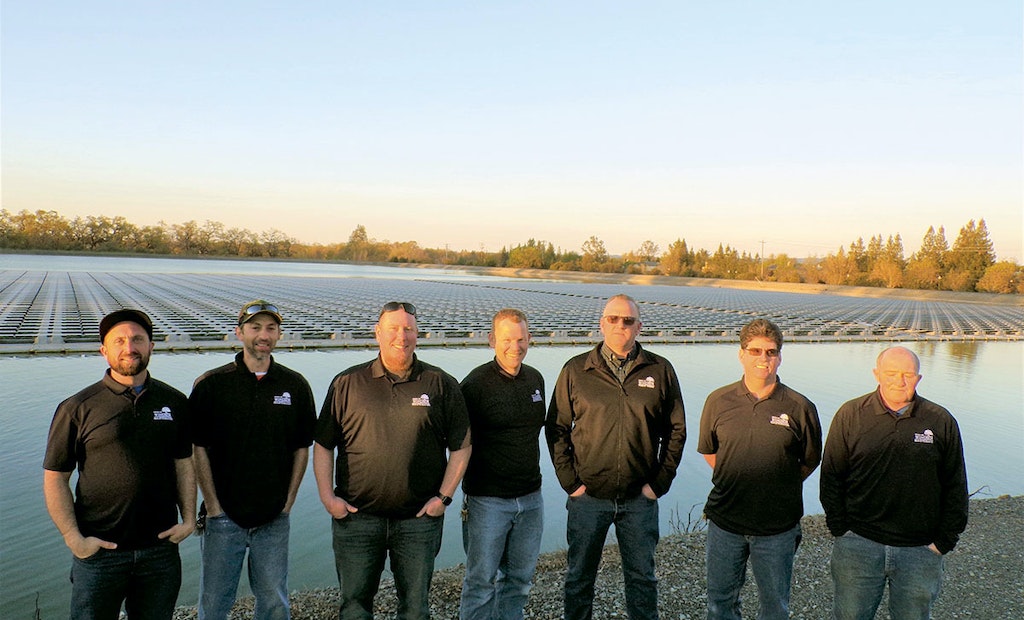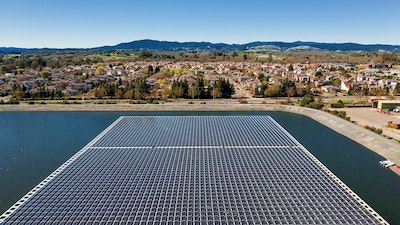
The Windsor Water Reclamation Facility staff includes, from left, Jason Sachs, operator; Jourdan Illingworth, utility maintenance mechanic; Fred Oster and Todd Darlington, operators; David Ernst, wastewater superintendent; and Richard Bevan and Mathew Underwood, operators.
Interested in Laboratory?
Get Laboratory articles, news and videos right in your inbox! Sign up now.
Laboratory + Get AlertsSignificant progress toward net-zero power consumption with solar energy only made the staff at the Town of Windsor Water Reclamation Facility in California think even bigger.
Why not go for an environmental impact trifecta: net-zero power, net-zero effluent discharge and net-zero biosolids waste?
“We started to really look at the way things are run,” says David Ernst, wastewater superintendent. “We said if we can recycle everything we have with 100% renewable energy, then let’s do it. It sounds like a lofty goal, but I think it’s within reach for our town.”
Looking deeper
The California utility completed a modernization study in 2019 that suggested some improvements to the plant, notes Veronica Siwy, deputy director of water and environmental management.
“When we looked at some of the improvements, we realized that if we just tweaked them a little bit, some things we had to do anyway, we were really close to achieving the net-zero concept,” Siwy says. “And then we figured if we could pursue that goal while achieving some of the necessary improvements, then Windsor could achieve something really cool.”
The Town of Windsor, population 26,000, is in Northern California about 45 miles from San Francisco. The water reclamation facility (2.25 mgd design, 1.2 mgd average) uses an activated sludge process with tertiary filter (Parkson DynaSand) and UV disinfection (a Trojan Signa system is scheduled for installation in 2024).
A large portion of the effluent is stored in a pond and used for irrigation. Effluent that can’t be recycled or stored flows into the Russian River via Mark West Creek. Biosolids are stored in ponds that have aerated water caps (Fluence Tornado aerators) to control odors. The solids are collected once a year by a contractor, centrifuged and applied to farm fields as Class B material.
Solar panels float
The town has a goal of net-zero carbon emissions by 2030. Solar power for the reclamation facility was the first step, since the plant was the source of 45% total greenhouse gas emissions. However, the town didn’t have enough land for a large solar array.
The solution was to use the surface of the 17-acre recycled water pond. The town entered a power purchase agreement with Ciel et Terre USA for a 1.8 mW floating solar array. Nearly 5,000 solar panels occupy about four acres of the pond, anchored to the berms around the pond so that they rise and fall as the water level fluctuates. Typically, the water is low in the summer, when demand for recycled water is highest.
The solar array went online in October 2020 and has done what utility staff intended: produce a large portion (72%) of the power for the treatment plant, the public works yard and administration building, and a pump station. The project won a 2021 California League of Cities Helen Putnam Award of Excellence in public works, infrastructure and transportation.
“We’re all very proud of it, and it has given us the energy to pursue even more sustainable projects,” Siwy says.
Five-part plan
The successful solar project led to a five-part plan to get all the way to net zero on power consumption, biosolids and recycled water. The plan, some parts in early development, involves updating parts of the reclamation plant, increasing recycled water infrastructure and collaborating with other utilities to develop regional water and wastewater solutions.
“We’re trying to implement these five parts together, so that all of these benefits come into play at the same time,” says Ernst. “That makes it exciting. We need all of these parts to work together so everyone has the best chance of success.” Here’s a closer look at the plan:
Aeration basin improvements
The utility plans to redesign or replace the secondary clarifiers; redesign or replace pumps, blowers and aerators; and to build a new aeration basin. The project is in early design but is expected to reduce energy use and operating costs, provide higher-quality recycled water, and offer some infrastructure redundancy.
Biosolids handling improvements
Ernst thinks this will provide the biggest sustainability gains. It includes converting open-air biosolids ponds to contained structures (BioDryer units) from Bioforcetech to produce 90% dry Class A EQ biosolids and recoverable heat.
The biosolids can be further refined through a separate pyrolysis process (high temperature without oxygen) to create biochar, a carbon-rich product that has numerous applications. Resulting syngas can be captured and burned to provide heat to continue the process.
“You end up using the greenhouse gas that is released through pyrolysis, similar to biogas capture in conventional anaerobic digestion,” Ernst says. “It does take some outside energy to kick the process off, but through drying and pyrolysis, you release methane, which then can be burned to fuel the process.” Some research indicates that pyrolysis may be effective at destroying PFAS.
Extending the recycled water system
The town plans to run a recycled water pipeline to a business district near the airport for irrigation. New residential developments are already required to have purple pipe systems, but so far not all are supplied with recycled water. Residents are usually eager to connect because recycled water costs less than potable water and is available even during drought when potable water use is restricted.
As the recycled system grows, potable water demand declines, conserving that resource. Also, the more wastewater is recycled, the less effluent goes to the river. In 2022, Windsor recycled 92% of its effluent. Surplus recycled water from the low-demand winter season can be stored to boost the supply for summer.
Combining with a nearby wastewater treatment plant
The town proposes to combine with a Sonoma Water treatment plant that needs an upgrading. Windsor’s plant can handle the added flow and could use some infrastructure at the other plant to increase recycled water storage capacity.
Regional collaboration
A group known as the Russian River Reuse Collaborative began meeting in fall 2022. Members besides Windsor include the cities of Cloverdale, Rohnert Park, Healdsburg and Santa Rosa and Sonoma Water. The group meets bimonthly to discuss regional opportunities for beneficial reuse and to promote regional planning to maximize resources.
“We realized that when we fit these components together, we could get to net zero,” Siwy says. “It was like a puzzle. Windsor is proud of the work we’ve done on sustainability. We feel like this could be another step in that direction.”
Northern California had a wet winter in 2022-23, so drought-related restrictions were lifted. Siwy thinks the drought made a lasting impression, helping create interest in regional cooperation: “I think the drought made us all a little more creative. It’s been unfortunate, but the positive side of it is giving people the drive to find better solutions for water management.”
Although most of the five-part plan is still in design, Ernst is encouraged by the progress toward the three net-zero targets: “We have a ways to go, but at the same time, I think we’re very close. When all these projects come online, net zero is within reach.”






